The Bushnell Holosight (first generation)
 sights for a few years, before getting one myself. I now have a pair, and
am considering getting a third. When first introduced, these sights cost something
close to $600. By the time I got mine, you could pick one up for something
over $200. This is still about what they cost today. This is the ultimate
in non magnifying sighting devices. There is no lining up of sights, no parallax,
and no focus to deal with. It is almost like playing a video game. With a
properly adjusted and mounted Holosight, you simply put the sight on the
target, and fire.
sights for a few years, before getting one myself. I now have a pair, and
am considering getting a third. When first introduced, these sights cost something
close to $600. By the time I got mine, you could pick one up for something
over $200. This is still about what they cost today. This is the ultimate
in non magnifying sighting devices. There is no lining up of sights, no parallax,
and no focus to deal with. It is almost like playing a video game. With a
properly adjusted and mounted Holosight, you simply put the sight on the
target, and fire. Unlike traditional "laser' sights, the Holosight does not project a beam onto the target. Instead, the laser is focused onto a holographically produced diffraction screen. This projects an image to the users eye, which seems to project out towards the target. These things really are amazing to see. The image seems to float out in front of the gun. No matter what the distance from the eye, apparent image size, and focus stay the same. Bushnell says that the apparent distance is 50 yards. I will just have to take their word for it. Unlike traditional reflex style red dot sights, the Holosight plane of focus lies far in front of the sight itself. It is also capable of generating (without parallax, of course) a better set of aiming tools, than a simple red dot, though a red reticle dot is available for the older 400 model.
The models I presently own are the older, first generation models. There is a new, smaller lighter model, which was introduced at about the time I picked up my first Holosight. I had considered the second generation unit, but a few things made me change my mind. The most obvious advantage of the earlier units is their ability to take interchangeable reticles. There are perhaps a dozen different styles available, out of which I have five, if you include the standard ring and dot. One is mounted on my Mech-Tech carbine, while the other sits atop my Calico carbine.
Old versus new
For carbine, or shotgun use, the older units slightly larger size, and higher weight are hardly noticeable. While the completely water proof construction of the new model is a comforting feature, water resistance is more than sufficient under most conditions. The wider range of brightness settings is a great feature, though there is a filter included with the older model designed to be used with NVD systems. While all of these features make the new model a bit more handy than the older model, none are really vital. There is, however, one feature offered by the older model, that the new model lacks. The older, 400 series, is capable of taking interchangeable reticles. This offers a fair amount of versatility, allowing the shooter to indulge his personal taste, or to tailor the site for various uses. It also offers easy, user replacement of a scratched, cracked, or otherwise damaged screen.
Interchangeable Reticles
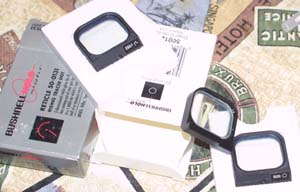 Holosight is a laser device. Do not change the reticles until you
are certain that the unit is off. The actual beam itself is blocked
when a reticle is in place, but with the reticle removed, the beam is exposed.
You are certainly risking damage to your eyes if you remove a reticle with
the power on. A laser is a laser, after all.
Holosight is a laser device. Do not change the reticles until you
are certain that the unit is off. The actual beam itself is blocked
when a reticle is in place, but with the reticle removed, the beam is exposed.
You are certainly risking damage to your eyes if you remove a reticle with
the power on. A laser is a laser, after all. Reticles are removed with a hex wrench, included with the Holosight. The little hex screw is not captive, so it will fall out, once loosened, if you are not careful. Once the screw is removed, the reticle can be slid out sideways. A new reticle is then slid in place, and the screw is tightened. That's all there is to it.
Over a dozen different reticle styles are available. Some are quite general, and their choice is a matter of personal preference, others are highly specialized to certain types of shooting. Among the specialized models are a ranging reticle deigned for archery, and a "Tombstone" model particularly suited to the Bianchi Cup competition. For most users, the standard reticle is more than sufficient. If you have a first generation Holosight, or are contemplating the purchase of one, I would recommend that you get any additional reticles quickly. Bushnell no longer makes them, and most of the stock has run out. I have seen some standard ring, triangle, and dual ring units (the least popular), still available, but most of the others are impossible to find.
|
|
|
| Loosen the old Reticle. This requires a hex wrench, included with the unit. The set screw is centered directly under the sight window. It must be removed completely, or the reticle will hang when you try to remove it. The up and down arrows visible at the side of the unit are membrane switches used to adjust image brightness. |
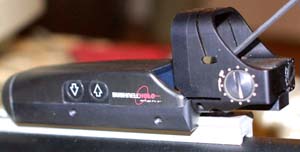
|
| Slide it out sideways. The reticle will not come straight out, and will not angle out. It must be gently slid sideways. |
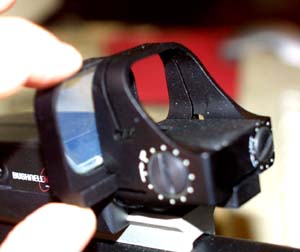
|
| Replace by sliding in new reticle. The new one goes in just the way the old one went out. visible on the left hand side of the viewing hood is the elevation adjustment. Off to the rear is the windage adjustment. No special tools are needed, both can be set using a coin. |
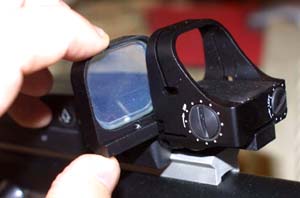
|
| Tighten new reticle down. Snug the screen down, so that it will not shift or rattle, and you are done. Visible to the rear of the viewing hood is the windage adjustment, off to the left, you can just make out the elevation adjustment. |
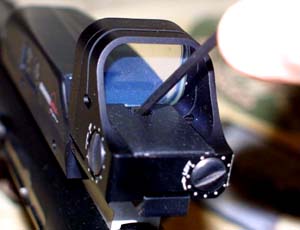
|
Some of the reticles available for the Holosight 400
Though there are a number of others available, these are the only ones I
have now. They are getting harder to find. When available, they are now selling
in the $50-$80 range.
| Standard | Essentially a 65 MOA ring with crosshair marks, and a 1 MOA dot in the center. | 
|
| Rising Dot | This is one of several 3 dimensional reticles made. A red dot sits centered under a 65MOA half circle. A red line seems to project out of the barrel of the gun to the red dot. | 
|
| Dual Rings | A 20 MOA rings sits inside of a 95MOA ring. | 
|
| Open Crosshairs | General purpose, this is a set of red crosshairs centered on a 30MOA circle. The target is not subtended. | 
|
| 20 MOA ring | A simple 20 MOA red ring. This is a great reticle for shotgunning. | 
|